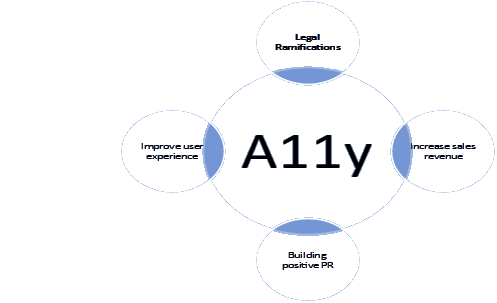Digital Accessibility – Why it’s so important?
What do you think, should everyone get equal access to online education, employment, healthcare, and ecommerce?
A BIG YES! Accessibility fosters independence. In the age of social media, it even means equal access to friendship and social growth. It empowers users with disabilities to navigate websites and use digital products independently without needing to enlist support from anyone.
We believe the world, online and off, is a better place when people of all abilities can participate in and access it equally. And we believe digital accessibility is necessary for creating that world.
Digital accessibility also helps people who don’t consider themselves disabled. If you’ve ever enlarged the text or image on your smartphone, for instance, you’ve tasted the
fruit of digital accessibility.
Web Accessibility vs Digital Accessibility
Web accessibility refersto the principle that websites and the technologies associated with them should be equally accessible to everyone, regardless of their disabilities.
Digital accessibility includes web accessibility plus
the accessibility of anything digital such as video, audio, electronic documents, animations, kiosks, and mobile apps.
Types of Disabilities |

|
||||
| Vision | Hearing | Mobility | Cognitive | ||
Why Accessibility?
|

|
If we don’t work diligently to make the web accessible, we risk barring in some capacity a quarter of the adult population from participating in the world online. That means people with disabilities won’t be able to do things like make online payments, book movie tickets, take classes online, easily keep up with friends who move far away, or access important information about their business and healthcare.
Not to mention, building an accessible digital content is the moral and just thing to do!
Improve user experience:
The goal of accessibility is to make products, services, and environments more usable by people with disabilities with
special attention to navigation, ease of use, text clarity, and more, accessibility best practices benefit all users..
Increase sales revenue:
Do you know if your digital content isn’t accessible to everyone, you’re excluding 1.3 billion (approximately) potential customers. However, with accessible designs we can target very larger customer base
Legal Ramifications:
Lawsuits alleging digital accessibility violations are increasing, and several high-profile companies have had to pay large settlements.
Following WCAG guidelines helps organizations stay compliant and avoid costly lawsuits.
|
|
For more details about web accessibility laws & policies refer: https://www.w3.org/WAI/policies/
Building positive PR: By creating an accessible application, you will be able to build the foundation of a positive brand image for your organization. Higher customer retention plus people with disabilities are more likely to recommend you to their friends and family.
Building positive PR: By creating an accessible application, you will be able to build the foundation of a positive brand image for your organization. Higher customer retention plus people with disabilities are more likely to recommend you to their friends and family.
Writing higher-quality code: Websites that are created with accessibility in mind, tend to have a higher-quality code base.
Anyone can make their own corner of the web more accessible. The point is to just keep accessibility in mind and start working on it from the beginning.
Refer to the Web Content Accessibility Guidelines (WCAG) which is the international accessibility standard established by the Web Accessibility Initiative (WAI), part of the World Wide Web Consortium (W3C). The WCAG includes technical recommendations on how to make web content more accessible for people with disabilities.
The WCAG has gone through several updates since it was first published in 1995.
Each iteration adds new requirements:
The WCAG is categorized according to the four (POUR): perceivable, operable, understandable, and robust. Each principle has testable success criteria classified by three levels – A, AA, and AAA – with the easiest being A and the most challenging being AAA.
We are here for you!
We at TAAS Technologies help you make your mission-critical business applications & digital contents accessible with our experienced accessibility consultants who has the skills to lead your team for inclusive design & early accessibility. Our services that are tailored to harmonize with the standards of the Web Content Accessibility Guidelines (WCAG) 2.1/2.2, as well as Section 508, Communications and Video Accessibility Act (CVAA), the Americans with Disabilities Act (ADA), UK - Equality Act 2010 (EQA), India - Rights of Persons with Disabilities Act, among many other international standards spanning the globe.
Write to us today to learn more about our comprehensive approach to digital accessibility, including our automated and manual accessibility auditing / testing capabilities.
Choose Color Scheme